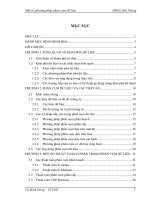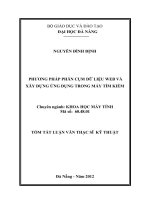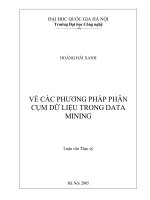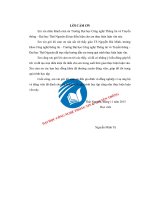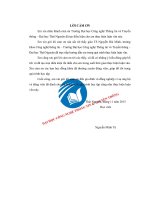Phương pháp gom cụm dữ liệu lớn
Bạn đang xem bản rút gọn của tài liệu. Xem và tải ngay bản đầy đủ của tài liệu tại đây (3.88 MB, 65 trang )
Note to other teachers and users of these slides: We would be delighted if you found our
material useful for giving your own lectures. Feel free to use these slides verbatim, or to
modify them to fit your own needs. If you make use of a significant portion of these slides
in your own lecture, please include this message, or a link to our web site:
CS246: Mining Massive Datasets
Jure Leskovec, Stanford University
High dim.
data
Graph
data
Infinite
data
Machine
learning
Apps
Locality
sensitive
hashing
PageRank,
SimRank
Filtering
data
streams
SVM
Recommen
der systems
Clustering
Community
Detection
Web
advertising
Decision
Trees
Association
Rules
Dimensiona
-lity
reduction
Spam
Detection
Queries on
streams
Perceptron,
kNN
Duplicate
document
detection
1/22/20
Jure Leskovec, Stanford CS246: Mining Massive Datasets
2
¡
Given a set of points, with a notion of distance
between points, group the points into some
number of clusters, so that
§ Members of the same cluster are close/similar to
each other
§ Members of different clusters are dissimilar
¡
Usually:
§ Points are in a high-dimensional space
§ Similarity is defined using a distance measure
§ Euclidean, Cosine, Jaccard, edit distance, …
1/22/20
Jure Leskovec, Stanford CS246: Mining Massive Datasets
3
x
x
x
x x x x
x xx x
x x x
x x
x
x x
x x x x
x x x
x
Outlier
1/22/20
x
xx x
x x
x x x
x
xx x
x
Jure Leskovec, Stanford CS246: Mining Massive Datasets
Cluster
4
A catalog of 2 billion “sky objects” represents
objects by their radiation in 7 dimensions
(frequency bands)
¡ Problem: Cluster similar objects, e.g.,
galaxies, nearby stars, quasars, etc.
¡ Sloan Digital Sky Survey
¡
1/22/20
Jure Leskovec, Stanford CS246: Mining Massive Datasets
5
¡
Intuitively: Music can be divided into
categories, and customers prefer a few
genres
§ But what are categories really?
¡
Represent a CD by a set of customers who
bought it
¡
Similar CDs have similar sets of customers,
and vice-versa
1/22/20
Jure Leskovec, Stanford CS246: Mining Massive Datasets
6
Space of all CDs:
¡ Think of a space with one dim. for each
customer
§ Values in a dimension may be 0 or 1 only
§ A CD is a “point” in this space (x1, x2,…, xd),
where xi = 1 iff the i th customer bought the CD
¡
For Amazon, the dimension is tens of millions
¡
Task: Find clusters of similar CDs
1/22/20
Jure Leskovec, Stanford CS246: Mining Massive Datasets
7
Finding topics:
¡ Represent a document by a vector
(x1, x2,…, xk), where xi = 1 iff the i th word
(in some order) appears in the document
§ It actually doesn’t matter if k is infinite; i.e., we
don’t limit the set of words
¡
1/22/20
Documents with similar sets of words
may be about the same topic
Jure Leskovec, Stanford CS246: Mining Massive Datasets
8
¡
We have a choice when we think of
documents as sets of words or shingles:
§ Sets as vectors: Measure similarity by the
cosine distance
§ Sets as sets: Measure similarity by the
Jaccard distance
§ Sets as points: Measure similarity by
Euclidean distance
1/22/20
Jure Leskovec, Stanford CS246: Mining Massive Datasets
9
1/22/20
Jure Leskovec, Stanford CS246: Mining Massive Datasets
10
¡
¡
¡
Clustering in two dimensions looks easy
Clustering small amounts of data looks easy
And in most cases, looks are not deceiving
Many applications involve not 2, but 10 or
10,000 dimensions
¡ High-dimensional spaces look different:
Almost all pairs of points are very far from each
other --> The Curse of Dimensionality!
¡
1/22/20
Jure Leskovec, Stanford CS246: Mining Massive Datasets
11
Take 10,000 uniform random points on [0,1]
line. Assume query point is at the origin
¡ What fraction of “space” do we need to cover to
get 0.1% of data (10 nearest neighbors)
¡ In 1-dim to get 10 neighbors we must go to
distance 10/10,000=0.001 on the average
¡ In 2-dim we must go 0.001=0.032 to get a
square that contains 0.001 volume
¡
¡
¡
1/22/20
$
%
In general, in d-dim we must go 0.001
So, in 10-dim to capture 0.1% of the data we
need 50% of the range.
Jure Leskovec, Stanford CS246: Mining Massive Datasets
12
Curse of Dimensionality: All points are very far
from each other
1/22/20
Jure Leskovec, Stanford CS246: Mining Massive Datasets
13
¡
Hierarchical:
§ Agglomerative (bottom up):
§ Initially, each point is a cluster
§ Repeatedly combine the two
“nearest” clusters into one
§ Divisive (top down):
§ Start with one cluster and recursively split it
¡
Point assignment:
§ Maintain a set of clusters
§ Points belong to the “nearest” cluster
1/22/20
Jure Leskovec, Stanford CS246: Mining Massive Datasets
14
1/22/20
Jure Leskovec, Stanford CS246: Mining Massive Datasets
15
¡
Key operation:
Repeatedly combine
two nearest clusters
¡
Three important questions:
§ 1) How do you represent a cluster of more
than one point?
§ 2) How do you determine the “nearness” of
clusters?
§ 3) When to stop combining clusters?
1/22/20
Jure Leskovec, Stanford CS246: Mining Massive Datasets
16
¡
Point assignment good
when clusters are nice,
convex shapes:
¡
Hierarchical can win
when shapes are weird:
§ Note both clusters have
essentially the same
centroid.
Aside: if you realized you had concentric
clusters, you could map points based on
distance from center, and turn the problem
into a simple, one-dimensional case.
1/22/20
Jure Leskovec, Stanford CS246: Mining Massive Datasets
17
Key operation: Repeatedly combine two
nearest clusters
¡ (1) How to represent a cluster of many points?
¡
§ Key problem: As you merge clusters, how do you
represent the “location” of each cluster, to tell which
pair of clusters is closest?
§ Euclidean case: each cluster has a
centroid = average of its (data)points
¡
(2) How to determine “nearness” of clusters?
§ Measure cluster distances by distances of centroids
1/22/20
Jure Leskovec, Stanford CS246: Mining Massive Datasets
18
(5,3)
o
(1,2)
o
x (1.5,1.5)
x (1,1) o (2,1)
o (0,0)
x (4.7,1.3)
o (4,1)
x (4.5,0.5)
o (5,0)
Data:
o … data point
x … centroid
1/22/20
Jure Leskovec, Stanford CS246: Mining Massive Datasets
Dendrogram
19
What about the Non-Euclidean case?
¡ The only “locations” we can talk about are the
points themselves
§ i.e., there is no “average” of two points
¡
Approach 1:
§ (1.1) How to represent a cluster of many points?
clustroid = (data)point “closest” to other points
§ (1.2) How do you determine the “nearness” of
clusters? Treat clustroid as if it were centroid, when
computing inter-cluster distances
1/22/20
Jure Leskovec, Stanford CS246: Mining Massive Datasets
20
(1.1) How to represent a cluster of many points?
clustroid = point “closest” to other points
¡ Possible meanings of “closest”:
§ Smallest maximum distance to other points
§ Smallest average distance to other points
§ Smallest sum of squares of distances to other points
§ For distance metric d clustroid c of cluster C is
arg min ∑.∈0 𝑑 𝑥, 𝑐 5
,
Centroid
Datapoint
X
Cluster on
3 datapoints
1/22/20
Clustroid
Jure Leskovec, Stanford CS246: Mining Massive Datasets
Centroid is the avg. of all (data)points
in the cluster. This means centroid is
an “artificial” point.
Clustroid is an existing (data)point
that is “closest” to all other points in
the cluster.
21
(1.2) How do you determine the “nearness” of
clusters? Treat clustroid as if it were centroid,
when computing intercluster distances.
Approach 2: No centroid, just define distance
Intercluster distance = minimum of the distances
between any two points, one from each cluster
1/22/20
Jure Leskovec, Stanford CS246: Mining Massive Datasets
22
Approach 3: Pick a notion of cohesion of clusters
§ Merge clusters whose union is most cohesive
Approach 3.1: Use the diameter of the merged
cluster = maximum distance between points in
the cluster
¡ Approach 3.2: Use the average distance
between points in the cluster
¡ Approach 3.3: Use a density-based approach
¡
§ Take the diameter or avg. distance, and divide by the
number of points in the cluster
1/22/20
Jure Leskovec, Stanford CS246: Mining Massive Datasets
23
When do we stop merging clusters?
¡ When some number k of clusters are found
(assumes we know the number of clusters)
¡ When stopping criterion is met
§ Stop if diameter exceeds threshold
§ Stop if density is below some threshold
§ Stop if merging clusters yields a bad cluster
§ E.g., diameter suddenly jumps
¡
1/22/20
Keep merging until there is only 1 cluster left
Jure Leskovec, Stanford CS246: Mining Massive Datasets
24
¡
It really depends on the shape of clusters.
§ Which you may not know in advance.
¡
Example: we’ll compare two approaches:
1. Merge clusters with smallest distance between
centroids (or clustroids for non-Euclidean)
2. Merge clusters with the smallest distance
between two points, one from each cluster
1/22/20
Jure Leskovec, Stanford CS246: Mining Massive Datasets
25
